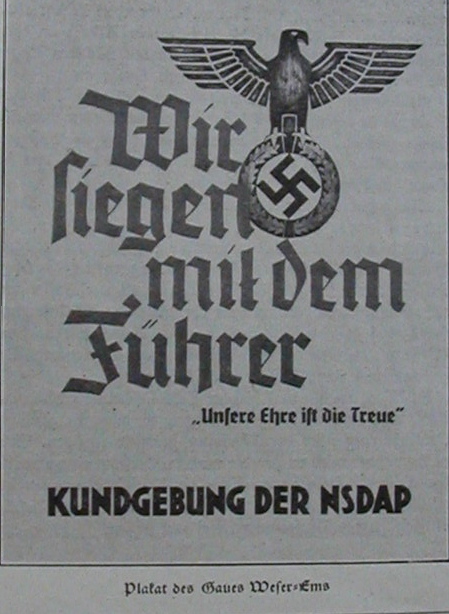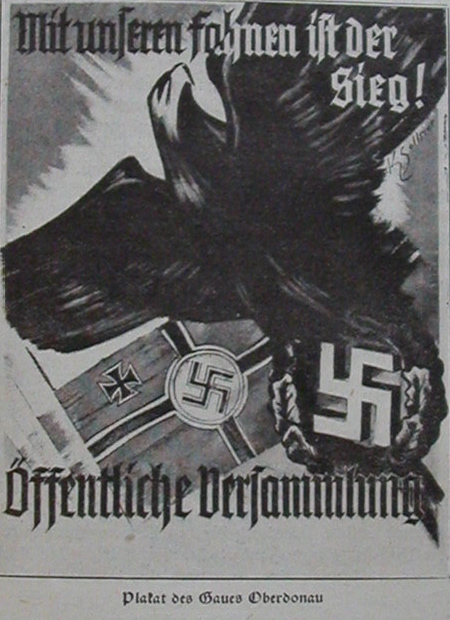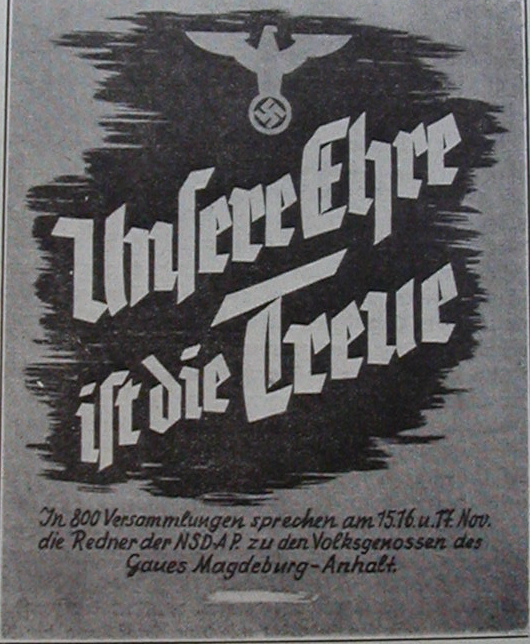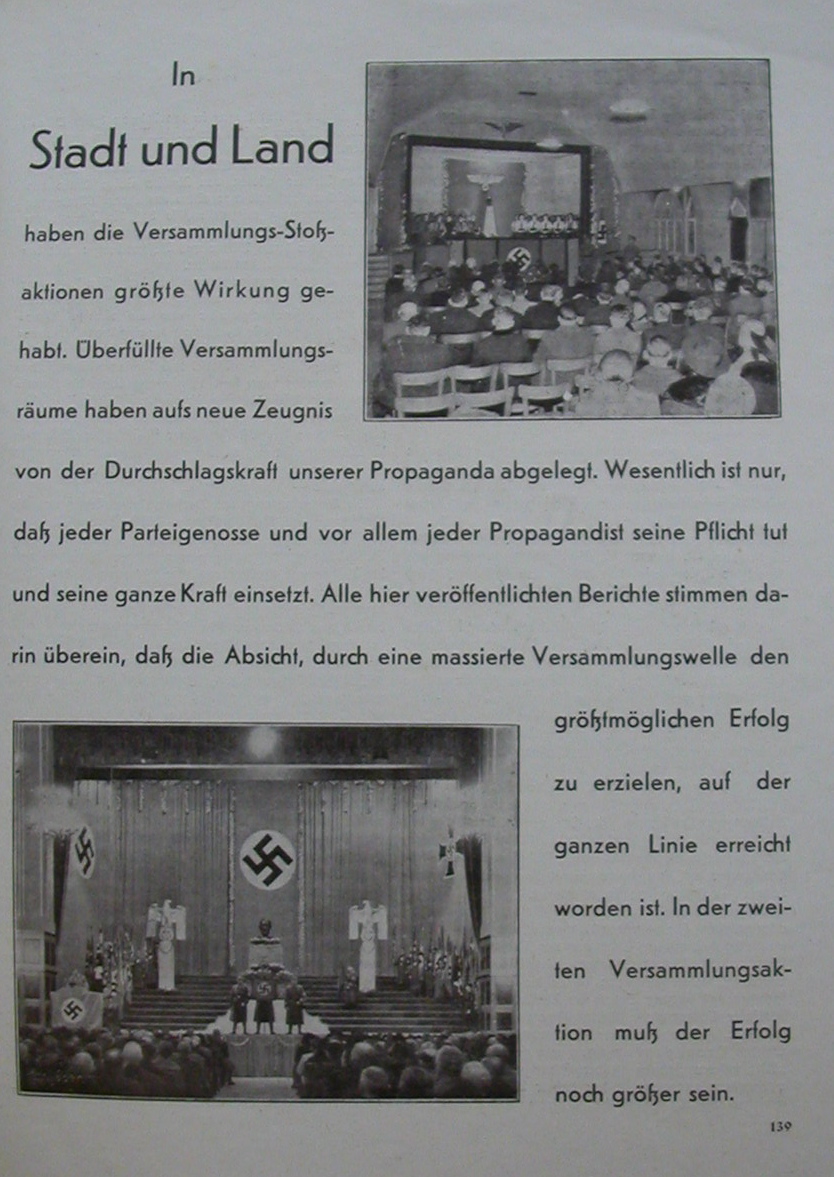


Background: During November 1940, the Nazi Party organized meeting campaigns throughout the country. Each Gau organized a large number of meetings, using its own speakers as well as those provided by the party’s national propaganda office.
Some party terminology will be useful. The Reichspropagandaleitung (RPL) was the national propaganda office. It had subordinate offices at the Gau, Kreis (county) and local group level. The Gauring was a coordinating group bringing together all party organizations and other clubs and organizations. It had subsidiaries at the Kreis level, and in 1940 sometimes but not always at the local level.
The reports are interesting in a number of areas. The statistics are useful, but the problems noted are also significant (getting fuel to transport speakers, for example, was no easy matter, given fuel rationing).
The article includes three Gau posters. I’ve also appended at the end a page with photographs of meetings.
The source: “So läuft die Winter-Aktion 1940/41,” Unser Wille und Weg, December 1940, pp. 133-141.
Gau Kurhessen Reports:
Following the RPL directive, the first wave of meetings of the war propaganda campaign was held on 15, 16, and 17 November. Its motto was: “We fight and win!”
 I. Propaganda preparations:
I. Propaganda preparations:
The following directives were issued at a meeting of the Kreispropagandaleiter:
The Kreispropagandaleiter are instructed to inform local group propaganda leaders of the tasks. — The work of local groups must focus on the meetings in the eight days prior to them.
II. Press:
III. Speakers received oral and written instructions on what to say in their speeches.
IV. Speaker assignments:
The Gaupropagandaleitung made available 145 Gau and Kreis speakers from our own Gau. The most capable Kreis speakers were used and for the first time permitted to speak outside their Kreis. They welcomed this opportunity.
The Reichspropagandaleitung assigned a further 45 Reichsredner and Stoßtruppredner, as well as Gauredner from adjacent Gaue.
Each Kreisleitung received the appropriate number of speakers for each of the three days.
The speakers remained in their assigned Kreis for all three days, each speaking to four meetings. They were housed together in a hotel in the Kreis capital. They were transported only by car. Each car brought three speakers to their meetings and back again that evening. About 70 cars were reserved from the party and its organizations.
The Kreisleitungen were instructed to take good care of speakers.
V. Conduct of the meetings:
The significance of the meetings was emphasized by the fact that the Gauleiter and the Kreisleiter were at the forefront of speakers during these days.
The goal of having a mass wave of meetings with the greatest possible success was achieved.
Since it had to be assumed that there would be some difficulties with such a mass use of speakers, substitute speakers were available so that each propaganda meeting could be held as scheduled.
About 800 meetings were held.
According to preliminary reports, attendance exceeded expectations. The meeting rooms were generally full and sometimes filled to overflowing. Attendance by women was particularly good, as was attendance by the military in area where they are quartered. Many districts reported that at least a third of the population attended; here and there some areas even reporting that every eligible voter attended.
Final attendance figures are not yet available. Given the total population of Gau Kurhessen of 900,000, however, attendance was between 160,000 and 230,000. This does not include mass meetings. The biggest meeting had about 1,000 attendees. In big cities, meetings were held in the local group areas.
VI. Evaluation by party leaders:
VII. Evaluation by speakers:
VIII. Overall evaluation:
Gau Steiermark Reports:
The first wave of meetings of the winter propaganda campaign 1940/41 was held on 8, 9, and 10 November. The only difficulty was working 9 November [the anniversary of Hitler’s 1923 Beer Hall Putsch] into the plan.
The unified motto was “One year of battle — One year of victory.”
Propaganda preparations:
The following were used: announcements in the press, leaflets, a poster, as well as newspaper showcases. The Gau and Kreis rings were particularly informed, as were the local group leaders and their colleagues.
Speakers were instructed, given the motto, to put the Führer and the achievements of the party at the center of their speeches.
Organizational preparations:
Speakers were assigned to a single Kreis. Because of their jobs, Gau speakers spoke in their home Kreis on 8 November, but were assigned to other Kreise on 9 and 10 November. On 8 November, Reichsredner spoke in nearly all major cities in the Kreise. These were followed by meetings in the countryside in the following days.
385 meetings were held, including each local group and some of the party outposts (Stützpunkte). Some places not reached because of technical reasons will be reached in the course of the month.
A major issue was transportation, above all fuel. I want to note the generous support of the Gau treasurer, party comrade Hruby, who provided fuel to the Kreise, and made available all Gau vehicles. He also made sure posters and leaflets were printed and supported us in all other ways. The various organizations also put their vehicles at our disposal.
There were scheduling conflicts with the KDF and other organizations, but these were worked out through the good offices of the Gau Ring. It would be an excellent idea if during the next wave of meetings there was a ban on other meetings so that the focus could be entirely on the meeting campaign.
Success of the campaign:
The campaign was a great success, based on reports to date and personal observation. The meetings were all very well attended. The speakers, despite the great effort of speaking four or five times, had an enthusiastic reception, and were given new energy for their difficult work. Special thanks is due to speakers from outside the Gau, whose confident and capable work showed selfless dedication.
Experiences and conclusions:
This campaign showed that a staff of energetic propagandists can carry out a campaign within a very short period of time that gives a united outlook to an entire Gau, the effects of which last for weeks, with the proper planning, execution, and above all, speakers.
It also showed that people’s comrades are more open to the questions of our day.
We propose that speakers constantly be reminded that all of today’s successes and great accomplishments were possibly only because of the faith of the little man, his sacrificial spirit, and his rock-hard confidence in the Führer and his movement, which created the foundations for our power today. Unfortunately, that is too easily forgotten today.
Finally, let me suggest that the exchange of speakers between Gaue was extraordinarily valuable for everyone involved, and that it should be continued. The fact is that many Gau speakers never have the opportunity to become RPL speakers. Allowing them to speak beyond Gau boundaries would give them the opportunity to improve their abilities, so continuing speaker exchange is welcome. This will broaden their outlook, giving those unknown drummers of the movement even today new encouragement in their selfless work.
Gau Oberdonau reports:
Our Gau was the first in the Greater German Reich assigned to carry out the first meeting wave of the winter campaign 1940/41 from 1 - 3 November 1940. Although there had been no previous meeting campaigns of this size, technical difficulties that first seemed insurmountable were resolved smoothly using past experiences.
 It order to eliminate problems of past meetings, the Gaupropagandaleitung sent all local groups a booklet that covered preparations, advertising, conduct, and setting for public meetings, as well as decorations, with examples [for a later version of that booklet, see a 1942 propaganda handbook from Gau Oberdonau]. The success was better than expected. Afterwards, it was clear that the usual mistakes were prevented, the decoration of meeting rooms was very satisfactory, and the conduct of meetings equally good. Alongside the usual meeting advertising, leaflets, using the Kreis rings, schools, etc.), there was intensive face-to-face and press propaganda (press announcements and headlines in the daily and weekly papers). [I was surprised to find less coverage in the major local newspaper than I expected. For a report from Linz, the Gau capital, see an article in the Linz Tagespost.]
It order to eliminate problems of past meetings, the Gaupropagandaleitung sent all local groups a booklet that covered preparations, advertising, conduct, and setting for public meetings, as well as decorations, with examples [for a later version of that booklet, see a 1942 propaganda handbook from Gau Oberdonau]. The success was better than expected. Afterwards, it was clear that the usual mistakes were prevented, the decoration of meeting rooms was very satisfactory, and the conduct of meetings equally good. Alongside the usual meeting advertising, leaflets, using the Kreis rings, schools, etc.), there was intensive face-to-face and press propaganda (press announcements and headlines in the daily and weekly papers). [I was surprised to find less coverage in the major local newspaper than I expected. For a report from Linz, the Gau capital, see an article in the Linz Tagespost.]
To ensure that the Gau and Kreis speakers got consistent instructions and information, Gau speaker and information material was produced. Besides the material on the general political line and the presentation of the Führer as the greatest statesman and military leader of all time, it also took note of the worries and concerns of the largely rural population. Given the difficult transportation situation, we were forced to assign each Kreis a staff of speakers from the Reichs- and Gaupropagandaleitung, which the Kreisleitungen then used to cover all the meetings in their area.
Given this absolutely necessary measure, it was naturally impossible to use speakers from the Reichspropagandaleitung only in the biggest meetings. This turned out to have advantages: 1. it ruled out unacceptable demands on means of transportation; 2. smaller groups welcomed the fact that they for the first time got strong speakers, even if they had never gotten one before. Despite difficulties in securing fuel, it was possible to bring nearly all speakers from the Kreis capital to their meetings by vehicle.
The speakers used in the meeting wave from the Reichs- and Gaupropagandaleitung met their tasks without exception, and in general left the population with the best impression.
There were few signs of weariness with meetings on the part of the population, evidenced not only by good attendance and the wish of nearly all local groups to have meetings again, but also by the fact that many who attended church services on All Saints Day went together to NSDAP meetings after the church services were finished.
According to reports we have received, the intensive propaganda work within a brief period of time within the entire Gau region proved far longer lasting and effective than normal meetings held over a longer period of time. There are 485 local groups within the Gau. 427 of them held a total of 365 meetings within three days, with a total attendance of 123,000. This was truly an above average success for this meeting campaign. This is particularly true since a large percentage of the male population was unable to attend given their work for the war effort.
Gau Schwaben reports:
The first wave of meetings of the war winter propaganda campaign 1940/41 was held on 15, 16, and 17 November.
After the details were discussed in the offices as well as in the Gauring, Kreisring meetings were held in each Kreis. The Gaupropagandaleiter provided orders to begin preparations immediately in the individual Kreise.
The speakers used in the campaign received monthly themes to provide them with the necessary background for the campaign.
Once the preparations were completed, the Gaupropagandaleiter assembled his Kreispropagandaleiter on 11 November to receive personal reports on preparations in the Kreise, during which employees in the Gaupropagandaleitung gave precise instructions for individual tasks in their area, e.g., written information to speakers on their assignments, caring for speakers, organizing transportation, coordinated meeting announcements, achieving the highest possible attendance, propagandistic organization of meetings, attracting members of affiliated and other organizations, etc.
The Gaupropagandaleiter then went through the details of this campaign once again.
Although many meetings had been held at the end of October and the beginning of November, a total of 427 public meetings were hold on 15, 16, and 17 November.
The success was extraordinary. All Kreise reported very good attendance, in most cases, meetings packed to overflowing. Never before had such a campaign given so impressive a picture of togetherness and unity. In some cases, people’s comrades were unable to be admitted, given the crowd. It must be emphasized that all classes of the population were represented.
It was generally reported that the speakers displayed passionate devotion to the Führer, people, and fatherland, and left deep impressions in the hearers. At times, the meetings became spontaneous mass meetings displaying loyalty to the Führer.
The meetings, both as a whole as well as in their conduct displayed a striking, large scale, and unified appearance.
The speakers, too, praised the meetings in every regard, and like the organizers themselves saw the first meeting wave of the war winter propaganda campaign 1940/41 as a complete success.
The speakers were assigned to a single Kreis, and were housed together in the Kreis capital, where the Kreisleiter was able to inform them of the particular needs of his area. The speakers received small presents of books with thanks.
Gau Franken reports:
The meeting campaign, part of the winter propaganda campaign 1940/41, took place in Gau Franken from 1 -3 November.
The theme of the campaign was: “Victory is with our flags.”
The 300 local groups in the Gau held 386 meetings. Mass meetings were held on the same day in 20 of the largest halls in Nuremberg, advertised by large posters and leaflets. The press covered the meeting campaign days before, and on its first day carried a list of all the larger meetings. No meetings were held in the Gau in the week preceding and the week following, in order to make the meetings stand out. The organizations that are part of the Gauring were instructed not to hold membership meetings during this period, but rather to inform their members of the party’s meetings.
All of the Gau speakers gave their full energy, sparing nothing. Speakers from outside the Gau proved extraordinarily valuable. All speakers had the same hotel as gathering place. This was a good idea, since it made it possible to be sure that all speakers left by vehicle or train smoothly. Of course, those speakers in the outlying Kreise were housed in the Kreis capital and properly cared for.
To carry out a meeting campaign, it is absolutely necessary that enough cars are available, since there are places that cannot be reached by train without subjecting the speaker to more than he should have to endure. The Gaupropagandaleitung therefore did everything possible to mobilize every available car for this period. It succeeded, thanks to the cooperation of the various Gau offices and other party offices.The Gau official in charge of fuel readily made the necessary amount of gasoline available.
According to reports by the Kreisleitungen and speakers, the meeting attendance was excellent.
The speakers also reported that they were entirely satisfied with the excellent preparation, decoration, and conduct of the meetings.
At the end of the first day’s meetings, mostly held in the cities, the Gaupropagandaleitung organized a gathering for all participating speakers. Speakers from outside the Gau were able to compare experiences and ideas with those speakers from within the Gau.
Gau Ost-Hannover reports:
Following the RPL directive, the first meeting campaign occurred on 8, 9, and 10 November 1940. The preparations assumed that this was a propaganda opportunity to use all available forces and means to conduct a campaign that is only seldom possible. It was an opportunity to prove that in the war year 1940/41, with many experienced propagandists having been called to serve in the military, the party could still conduct propaganda of the type that was formerly customary during the years of struggle.
At a meeting of the Kreispropagandaleiter, at which the Gau speakers also participated, the significance and purpose of the campaign was outlined, and the directives for individual areas given.
On the following Saturday or Sunday — a week prior to the start — meetings were held with local group leaders or propaganda leaders in conjunction with the Kreis rings.
The press received general instructions, and the editors received information on the significance and purpose of the campaign, and told to use their initiative. In the individual Kreise, the press was carefully directed. This was a complete success. During these days, the press looked as it had during plebiscites and Reichstag elections. There were articles by the editors, appeals by the Kreisleiter, daily references to the meetings in the news columns of the newspapers, and big advertisements from the Kreisleitungen that listed all meetings during the three days.
The Gaupropagandaleitung provided the Kreise with sufficient copies of a poster. That could be filled in by the Kreise with the necessary information (name of speakers, meeting locale, and time, etc.), so that even the smallest local group in the countryside could hang a flawless, printed, and effective poster.
Most Kreise also provided their local groups with the necessary flyers, which were delivered to each household on a certain day before the meeting. Leaflets were also used to reach the population and invite them to the meetings.
Some local groups held propaganda marches with the S.A., HJ, and other groups, and also propaganda vehicles with banners saying “Victory is with our flags.” When available, loudspeaker trucks were also used in more heavily populated neighborhoods.
Several movie theaters showed slides to advertise the meetings.
Finally, speakers from outside the Gau were asked for biographical information, particularly their involvement in the movement, so that the Kreispropagandaleiter could use press propaganda to inform the population about the speakers using pictures and information.
The local groups used the local [propaganda] rings as well as the most important propaganda method, face-to-face propaganda. They also prepared for and organized the individual meetings. Face-to-face propaganda supplemented the press, leaflets, flyers, and meeting posters. Nearly all local groups did this, as much as local conditions allowed — Gau Ost-Hannover is primarily an agricultural region with widely-separated villages and local groups often cover considerable territory.
Decorating meeting rooms and organizing the meetings themselves is of decisive importance for their success. Aside from dignified decorations of the stage and the removal of all distracting posters, pictures, and other things from the room, if at all possible, under today’s conditions, text banners with effective slogans are valuable. This was done during the campaign whenever possible.
Given the heroes’ memorial on 9 November, the stages were decorated appropriately and the speakers was instructed to consider the importance of the day, being sure that the meetings on 9 November did not in any way lose the characteristics of propaganda mass meetings. It was clear afterwards that this succeeded in most cases, although party members and populace were accustomed to a solemn ceremony on 9 November.
The Gau had a total of 44 outside speakers for the campaign (Reichsredner, Stoßtruppredner, Gauredner from the RPL, Gauredner from neighboring Gaue), along with 80 Gauredner, Kreisredner, and Kreisredner applicants. The Kreisredner applicants were used only to a limited degree. The 44 speakers from outside the Gau spoke at 120 meetings, the Gau’s own speakers at 192, with a total of 312 meetings. Accurate statistics show that 93,400 party members and people’s comrades, out of the Gau’s population 958,000, attended 312 meetings. It should be noted that not all Kreise could fully use the meeting days due to enemy air attacks, and in some Kreise it was only possible to hold meetings on Sunday.
The campaign was a complete success. The carefully planned and conducted propaganda met its goal. The party’s meetings became the topic of people’s daily conversation, and not only were the meeting rooms full or overflowing, but also some could not hold all people’s comrades who wanted to attend, so that some had to go back home. It was particularly noted that many people’s comrades attended who usually are not seen at the party’s events. The campaign also proved that the population can be drawn to our meetings despite English air activity if they are properly done.
The fact that the speakers, particularly those from outside the Gau, generally went over very well and were effective, is also a sign of the meeting campaign’s success.
That, however, is not the main success of the whole campaign. Particularly valuable, and not to be underestimated, is the fact that political leaders in the Kreise and local groups met the challenges given them, which under the present conditions was not easy. This gave them new energy that they will be able to use in taking on future party tasks during this winter.
One more thing must be noted about this meeting wave. That is the fact that it is possible to present the populace with speakers that they have not seen or heard before. That was true not only for speakers from outside the Gau, but also for the Gau- and Kreisredner. During this three-day campaign, it was possible to use Gauredner at meetings where they otherwise could hardly be sent because of other circumstances and transportation difficulties. The Kreisredner were also exchanged, so that these meetings also had fresh speakers.
The Gau treasurer contributed to the success by allocating sufficient resources. Kreise and local groups were in a position to secure all necessary items such as posters, leaflets, newspaper ads, music for meetings, decorations, etc.
This first meeting campaign in Gau Ost-Hannover proved that even during war it is possible to carry out successful propaganda by bringing together all available personnel and resources, and we look forward to the next major campaign during the second wave of the war winter propaganda campaign.

The meeting campaign had the greatest effect both in cities and in the countryside. Packed meetings gave new evidence of the force of our propaganda. The only thing that is important is for each party comrade, and above all each propagandist, to do his duty with all his strength. The reports published here agree that the goal of having a major wave of meetings with the greatest success possible was met everywhere. The success of the second meeting campaign must be even greater.
Last edited 17 November 2025
Page copyright © 2010 by Randall Bytwerk. No unauthorized reproduction. My e-mail address is available on the FAQ page.
Go to the German Propaganda Home Page.